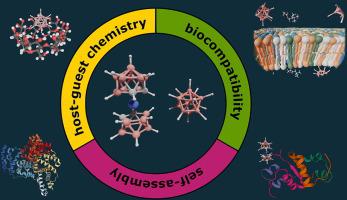Coordination Chemistry Reviews ( IF 20.3 ) Pub Date : 2022-11-29 , DOI: 10.1016/j.ccr.2022.214940 Jakub Cebula , Krzysztof Fink , Janusz Boratyński , Tomasz M. Goszczyński

|
It has been almost 50 years since the term “supramolecular chemistry” was coined to describe chemistry beyond the molecule. Since its beginning, supramolecular chemistry has often been intertwined with biology; noncovalent interactions of biomolecules have been described long before this term was even created. Here, we want to show that supramolecular chemistry and biology can (and should) intertwine more with a slightly forgotten branch of chemistry – the chemistry of boron clusters. The revived interest in boron cluster chemistry is connected with major discoveries in their physicochemical and biological properties. Due to various interaction possibilities, boron clusters can form host–guest complexes with classic hosts such as cyclodextrins and with other biomolecules such as proteins. Boron clusters can also diffuse across biological membranes and be used as membrane carriers for other molecules that normally cannot cross membranes. The properties and chemistry of boron clusters can also be exploited in the synthesis of various nanoparticles (closomers, gold, and polymeric nanoparticles). This article outlines the current and potential usages of boron clusters’ supramolecular properties in biological applications.
中文翻译:

阴离子硼簇的超分子化学及其在生物学中的应用
自创造“超分子化学”一词来描述分子之外的化学以来,已经将近 50 年了。从一开始,超分子化学就经常与生物学交织在一起。生物分子的非共价相互作用早在这个术语被创造出来之前就已经被描述过了。在这里,我们想表明超分子化学和生物学可以(并且应该)与一个被遗忘的化学分支——硼簇化学——更多地交织在一起。对硼团簇化学的重新兴趣与其物理化学和生物学特性的重大发现有关。由于各种相互作用的可能性,硼簇可以与经典主体(如环糊精)和其他生物分子(如蛋白质)形成主客体复合物。硼簇还可以扩散穿过生物膜,并用作通常不能穿过膜的其他分子的膜载体。硼簇的性质和化学性质也可用于合成各种纳米粒子(闭合体、金和聚合物纳米粒子)。本文概述了硼簇的超分子特性在生物应用中的当前和潜在用途。










































 京公网安备 11010802027423号
京公网安备 11010802027423号